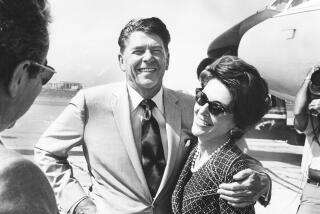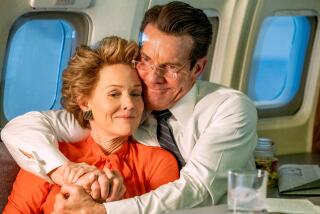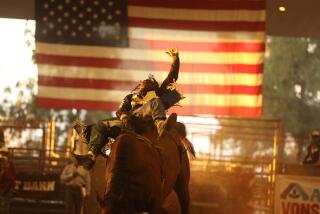Presidential Cowboy
In one of the videos that run throughout the Reagan library, Reagan admits that, however challenging and fascinating life as president might have been, sometimes he just had a hankering to be on the ranch--his “Rancho Cielo” getaway north of Santa Barbara. He would rather have been in the saddle. Literally.
He was, it seemed, not only a Hollywood denizen, but a cowboy at heart. Or did one inspire the other? The line between show biz, culture and politics gets especially blurry in Reagan’s case, a fact we are reminded of perusing “Cast for a President: Sculpture From the Collection of the Reagan Presidential Library.”
The exhibition of western art and sculpture, given as gifts to Reagan during his White House tenure, drips in portraiture. Not only are numerous Reagan sculptures scattered throughout the sculptures of western scenes and animals, but we hear the man’s voice, wafting over from the next gallery in the library.
There he is, in Snellen Johnson’s “Mr. President,” riding tall in the saddle with his imperturbable grin, waving amiably as if to a neighbor or to a TV audience of millions.
There he is, next to a bronze, of another Southern California faux cowboy, John Wayne, awash in heroism in Jessie Corsault’s “Red River.”
Reagan on horseback is the exhibition’s recurring leitmotif, as in Vic Lemon’s “Lot of Grit.” He looks suitably calm in Glenna Goodacre’s “After the Ride” and suitably battle-agitated in “Ronald Reagan as General George Armstrong Custer,” fashioned by Tom Freeman after the film “Santa Fe Trail.” Hollywood calling again.
One of the most startling pieces here is a large tableaux fashioned from cut, tooled and painted leather, “Rancho Cielo, The Attack of the Stagecoach,” made in 1985 by Kuzuyuki Makhjima for Reagan’s ranch. The gnarled, action-packed composition depicts Native Americans attacking a stagecoach, hardly a politically correct emblem for a president’s lair, one would think.
Elsewhere, though, Native American life is offered a more kindly and sympathetic representation, even when it’s sentimental kitsch like Maher Morcos’ “The Only Good Indian Is . . . (American Indian offers his canteen to a cowboy dying from thirst).” John Nieto’s “Delegate to the White House” is a rough-hewn oil painting of a stately Native American chief. A “Navaho Union Flag Rug” on display pays tribute to the white man’s flag. But it appears in the ambivalent form of a rug, sending a cleverly mixed message.
No doubt, this was intended to be a casual summer show, but the work here stirs up questions in any thinking visitor. And although social and political considerations almost become moot regarding the exhibition’s several animal sculptures, one could read implicit tragedy into the buffalo sculpture of Bruce Brady’s “Tatanka,” a tribute to another victim of the taming of the Wild West.
Meanwhile, back in another part of the library, the full-scale replica of the Oval Office circa the Reagan years takes on a new meaning after viewing this show. There, we notice anew the scattered western art figurines, in what is one of the nerve centers of American life and public policy. One can’t help but speculate on the causal relationship of the man and his cultural appetites, his cowboy ethics and horse sense.
Is it possible that the presence of western art, all the equestrian sinew and bucking broncos, had some influence over Reaganomics, his back porch “Great Communicator” patter or even Iran-Contra? We will never know, but the questions arise, like knots in kindling logs, popping in a campfire.
DETAILS
“Cast for a President: Sculpture From the Collection of the Reagan Presidential Library,” through September at the Ronald Reagan Presidential Library, 40 Presidential Drive, Simi Valley. Gallery hours: daily, 10 a.m. to 5 p.m. 522-8444.
*
Josef Woodard, who writes about art and music, can be reached by e-mail at joeinfo@aol.com.
More to Read
The biggest entertainment stories
Get our big stories about Hollywood, film, television, music, arts, culture and more right in your inbox as soon as they publish.
You may occasionally receive promotional content from the Los Angeles Times.










